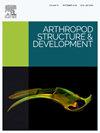Insights for the subtribal-level phylogenetic reconstructions in Paederinae (Coleoptera: Staphylinidae): a study on mesoventral plate with elements of comparative morphology
IF 1.3
3区 农林科学
Q2 ENTOMOLOGY
引用次数: 0
Abstract
Morphological characters are one of the bases for describing any organismal group and comparative morphology plays an important role in taxonomy, systematics, and evolutionary research. Yet, in many groups, especially highly diverse, the terminology and homology of morphological structures are poorly understood. One of such examples is the mega-diverse group of animals, rove beetles (Staphylinidae), where comparative studies are very rare, both across the subfamilies and within them. In this paper, we present our results of morphological examination of mesoventral sclerotisation across different subtribes and genera of Paederinae, which is one of the most diverse rove beetle subfamily. Additionally, we compare them with several representatives of Staphylininae and Xantholininae. We revise morphological terminology for the mesoventral area in Paederinae and propose a hypothesis for character homologisation within Paederinae and across the listed subfamilies. Our results are based on examination of representatives of 157 Paederinae genera and the major groups are illustrated by schematic drawings and SEM scans. Additionally, we introduce new characters with potential importance for subtribal level phylogenetic reconstruction of Paederinae relationships. This is the first comprehensive review of the mesoventral area for the subfamily.
对拟蚊科(鞘翅目:拟蚊科)亚部落级系统发育重建的认识:中腹侧板的比较形态学研究
形态学特征是描述任何生物类群的基础之一,比较形态学在分类学、系统学和进化研究中起着重要作用。然而,在许多群体中,特别是高度多样化的群体中,形态学结构的术语和同源性知之甚少。其中一个例子就是种类繁多的动物群,花车甲虫(葡萄球菌科),在这个亚科之间和它们内部的比较研究非常罕见。在本文中,我们提出了我们的形态学检查结果在不同亚部落和属的Paederinae中腹硬化症,这是最多样化的罗非虫亚科之一。此外,我们还将它们与葡萄碱科和黄碱科的几个代表进行了比较。我们修订了Paederinae中腹侧区的形态学术语,并提出了Paederinae和所列亚科之间的特征同源性假设。我们的研究结果是基于对157个白蛉属代表的研究,主要类群通过示意图和扫描电镜进行了说明。此外,我们还引入了在亚部落水平上对拟羽科亲缘关系的系统发育重建具有潜在重要性的新性状。这是该亚科首次对中腹侧区进行全面的研究。
本文章由计算机程序翻译,如有差异,请以英文原文为准。
求助全文
约1分钟内获得全文
求助全文
来源期刊
CiteScore
3.50
自引率
10.00%
发文量
54
审稿时长
60 days
期刊介绍:
Arthropod Structure & Development is a Journal of Arthropod Structural Biology, Development, and Functional Morphology; it considers manuscripts that deal with micro- and neuroanatomy, development, biomechanics, organogenesis in particular under comparative and evolutionary aspects but not merely taxonomic papers. The aim of the journal is to publish papers in the areas of functional and comparative anatomy and development, with an emphasis on the role of cellular organization in organ function. The journal will also publish papers on organogenisis, embryonic and postembryonic development, and organ or tissue regeneration and repair. Manuscripts dealing with comparative and evolutionary aspects of microanatomy and development are encouraged.

 求助内容:
求助内容: 应助结果提醒方式:
应助结果提醒方式:


